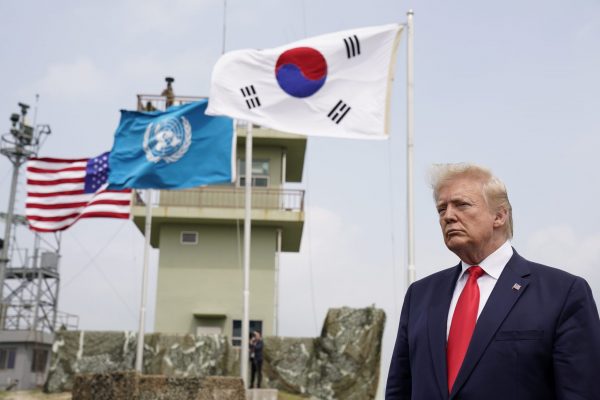Trump and Moon visited the demilitarized zone that separates the North and South where they met with North Korean leader Kim Jong-un after Trump sent him a last-minute invitation via Tweet. This saw Trump become the first US president to set foot on North Korean soil and hold an impromptu meeting with Kim. But despite the fanfare, it is unclear if these efforts will kick-start negotiations towards the realisation of a denuclearisation grand bargain.
More than a year has passed since Trump switched course on North Korea away from ‘maximum pressure’, becoming the first sitting US president to meet with a North Korean leader at the June 2018 Singapore summit. Trump’s decision to meet with Kim Jong-un was criticised as giving North Korea a propaganda victory while the Singapore summit joint statement was criticised for failing to articulate concrete measures on how denuclearisation would be implemented. These criticisms miss the bigger picture.
North Korea and the United States are still in a technical state of war that has continued since the end of the Korean War in 1953. The long history of international attempts to denuclearise North Korea — from the 1994 Agreed Framework to the Korean Peninsula Energy Development Organization (1995–2006) to the Six-Party Talks (2003–2009) — has seen promises broken on both sides. Rhetoric in 2017 descended to now forgotten lows that heightened the risk of accidental conflict, with Trump threatening to unleash ‘fire and fury’ on the ‘short and fat’ ‘rocket man Kim’ and Kim vowing to tame Trump, ‘the mentally deranged US dotard’. The approach taken in Singapore, which identified trust-building as a prerequisite, was therefore a positive step forward.
Trump and Kim’s second summit in Hanoi, Vietnam, in February 2019 jumped the gun and ended half a day early when the two leaders failed to make any progress. Holding a second summit so soon after the first, despite having nothing to announce, was a mistake. Some speculate that Trump timed the visit in an attempt to give him a foreign policy win to deflect domestic attention as FBI special prosecutor Robert Mueller delivered his report on the Trump campaign’s ties to Russia and obstruction of justice. Others speculate that US National Security Advisor John Bolton played the role of saboteur with demands designed to undermine the process, such as seeking North Korean declarations against chemical and biological weapons too.
As Alexandra Bell explains in our lead essay this week, the gap between the United States and North is still vast. ‘Negotiations lack a shared definition of “denuclearisation” … There is no agreement on which North Korean facilities and installations will be available for the purposes of verification … There is no understanding about when and if North Korea will join or re-join international weapons agreements like the Non-Proliferation Treaty …. There is no clear picture of how US military exercises and assets in the region will be altered or withdrawn. There has been little public progress on if or when a formal end to the Korean War will be established’.
Another potential hazard, Bell explains, is the way Trump has positioned the negotiations by connecting them to his ‘personal relationship’ with Kim. ‘By making it personal, Trump could perceive a hard-line from Kim as a rejection of friendship. The world might then see that hell hath no fury like a president scorned’. Rather than anchoring the negotiation process inthe two leaders’ personal ‘chemistry’ and jumping the gun again with a fourth meeting, Trump and Kim would be wise to empower their negotiators ‘to go about the slow and tedious process of hammering out concrete concessions — from both sides’.
Hitoshi Tanaka, the former Japanese deputy foreign minister who negotiated the 2002 Japan–North Korea summit between then Japanese prime minister Junichiro Koizumi and then North Korean leader Kim Jong-il, argues that three key elements are needed to realise successful outcomes.
First, confidence-building measures are needed in order to overcome the deep US–North Korea ‘mutual mistrust and establish the credibility of the negotiating process’. This should include North Korea publicly recommitting to its moratorium on missile and nuclear testing and the establishment of US and Japanese liaison offices with North Korea.
Second, negotiations must focus on formulating ‘parallel roadmaps that lay out step-by-step approaches for both denuclearization and the establishment of a permanent peace regime on the Korean Peninsula’. Such an approach gives the best shot of successful implementation.
Past agreements tended to fail not because of disagreements on the contents of the framework, but due to the ‘lack of a precise roadmap for carrying out the agreed measures, including details on the sequencing of steps and the methods of implementation’. The ‘simultaneous and linked implementation’ of denuclearisation and peace treaty roadmaps is critical to overcome the trust deficit, given North Korean fears of ‘denuclearisation today and regime change tomorrow’, as with Libya. Meanwhile, the United States is concerned about giving up too much of its sanctions leverage too early in the process and being left to buy the horse again.
Third, after a roadmap is hammered out, the process should be multilateralised through the Six-Party Talks. Any agreement reached is bound to encounter implementation obstacles and ‘will be more sustainable in the long run if it includes all relevant countries in the region’. International economic assistance to rehabilitate the North Korean economy after it denuclearises will also ‘require funds not easily raised by any single country’.
The realisation of a grand bargain with North Korea will require all parties to commit to a long-term process. There are no shortcuts in such a complex undertaking to transform the regional security landscape. As Bell concludes, ‘regular, old, plodding diplomacy is the only real way to achieve security on the Korean Peninsula’.
The EAF Editorial Board is located in the Crawford School of Public Policy, College of Asia and the Pacific, The Australian National University.

